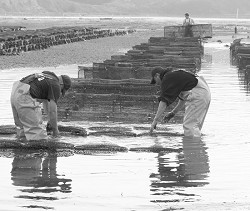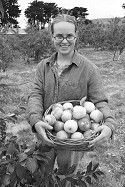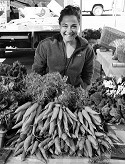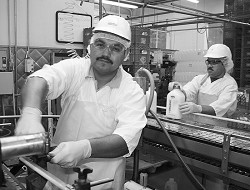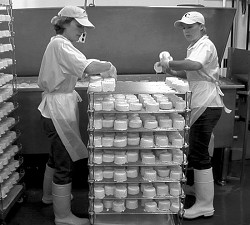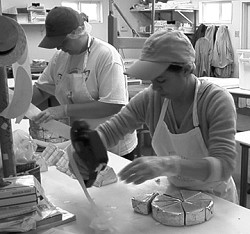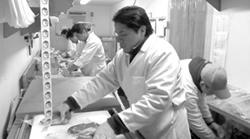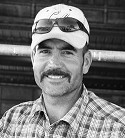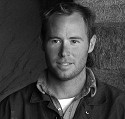What a delight we enjoy when we pop a Hog island oyster into our mouths, bite into a fresh local apple from Chileno Valley Ranch, open a pint of awesome Straus Organic Ice Cream, or enjoy crispy fresh organic salad from Star Route Farms. We take it for granted - we, the finishers of the process, the eaters and ultimate enjoyers of the spoil - that these products are miraculously conjured up through the images of the farmers whom we all know and see. Behind the farmers are hundreds of gifted and skilled men and women who nurse these products, such as oysters, along the way to our tables, sometimes for years at a time.
In Marin, half our farms and ranches report hiring farm labor, with 500 workers employed by producers as both part-time and full-time employees. There are 11 farms in Marin that report using migrant farm labor. Almost $3 million is spent on on-farm employee payroll (Census of 2002).
Of the 108 farms that have employees, 27% have five or more employees, while 73% report employing four or fewer workers.
Let's take a closer look "behind the scenes" at some of these operations and direct processors. Hog Island Oyster Company employs 50 men and women who work the Tomales Bay Estuary mudflats, the oyster farm on the shore, and in the office. The guys are on the job early, and with the low tides, have acres of oysters to look after, keep free from barnacles, and move through different stages in the bay. From little baby oysters a quarter inch wide, through various stages of growth, the men move the oysters many times to locations offering the best tidal nutrition, nursing the oysters for up to four years, through fair weather in the summer and fall to ferocious weather in the winter months.
Interns and new-entry young farmers make up a growing population on the organic and micro farms. These dedicated young people love what they do and add a much-needed youth element to an aging farm community. Dennis and Sandy Dierks of Paradise Valley Produce bring on five or six young interns each year to help and learn how to grow organic vegetables.
Tucked away in the hills of Marshall lies Straus Family Creamery, quietly producing the luscious organic milk, butter, yogurt, and ice cream that we all love so much. Each morning, very early, a hardworking crew arrives for a full day's production. The place is a veritable beehive of orchestrated activity from bottle washing to butter churning to ice cream making. The creamery is more like a craftsman's studio than an industrialized food factory. The machinery moves at a moderate clip, watched over by crews who have been on their jobs for years. The creamery has four full-time mechanics servicing the bewildering array of pasturizers, churners, bottling lines, and yogurt-making equipment. They are highly skilled professionals, and move about quickly but easily. The equipment is small-scale by today's industrial standards and much is still done by hand the old-fashioned way, which adds a real element of care and quality to the products.
For such a small operation, Cowgirl Creamery puts out an astonishing amount of cheese under the guidance of three cheesemakers and five others who wrap, pack, and ship the organic soft cheeses out the door. Once again, these people are working very early in the morning, focused on producing these award-winning cheeses. Everything is fashioned meticulously by hand, from pasteurizing the fresh organic milk from Straus Family Creamery, to hand-wrapping and packing the cheeses.
Marin Sun Farms, owned and operated by David Evans, has made a real contribution to our appetite for fresh, local, and healthy food. Behind the Marin Sun Farms label is a team of butchers and meat cutters who can only be referred to as craftsmen. Watching them perform their tasks at the butchery is like watching some kind of ballet of hands and knives and red meat, all smoothly synchronized. This whir of white jackets and quick hands and flawless packaging is the final step in bringing product that began with the sun, was transformed into grass to food, and will be served at someone's dinner table.
Robert Vallejo grew up on a dairy farm in Mexico, and was trained by his father. When he came to the U.S. twenty years ago, he signed on as a temporary hand at the Straus Blakes Landing Dairy Farm, and is still there today, managing the milking operation and the herd. He loves what he does and is constantly keeping up with the changing world of dairy. "Albert sent me to school right away to learn breeding and cow health," he says "and I am always having to learn more things. When we switched to organic, no one else had done that. We had no one to talk to. Now we are the experts and others come to us!" he says.
When we asked him how he feels about his job as herdsman for the organic dairy he said, "I like it because I know we are doing the right thing. There is nothing harmful in what we do. It's healthy for the cows, for the people who drink our milk, and for me too!"
Those crisp wedges of Point Reyes Original Blue Cheese that you find in specialty food stores really begin their life in rich grass pastures of the Giacomini Dairy Ranch in Point Reyes Station. The Holstein herd converts this grass to luscious raw milk. Each morning and evening, Paul Zimmerman, a fourth generation herdsman, brings in the herd to be milked. He designs the breeding program, follows the cows' nutritional rations, keeps track of the individual milking yields, and records and carefully follows the health and well-being of the 250-cow herd. Without Paul and other dairy producers here in Marin and Sonoma counties, we would have no blue cheese, cottage cheese, ice cream, or fluid milk. These farm workers are the root of all of our bountiful agricultural products. Paul says "When people go the market and pick up their food, I hope they sometimes remember who makes their food. It's us, the farmers. We make it."
